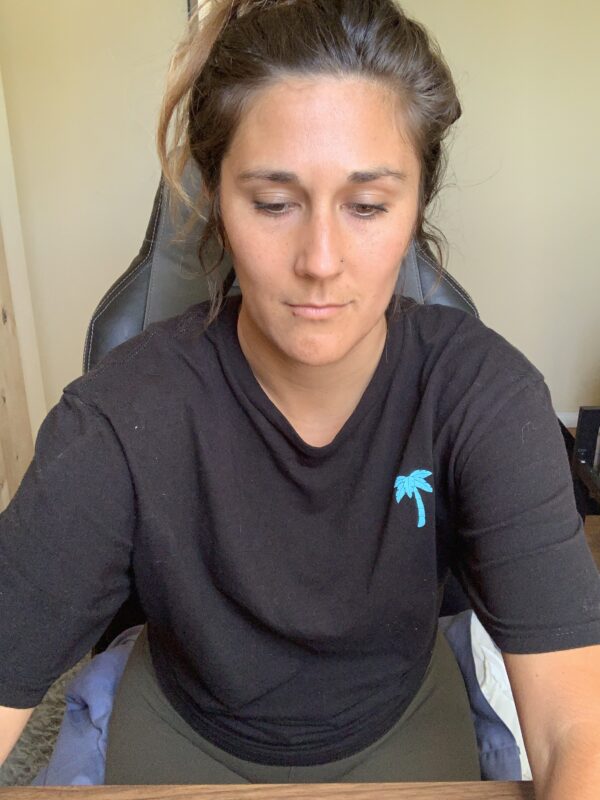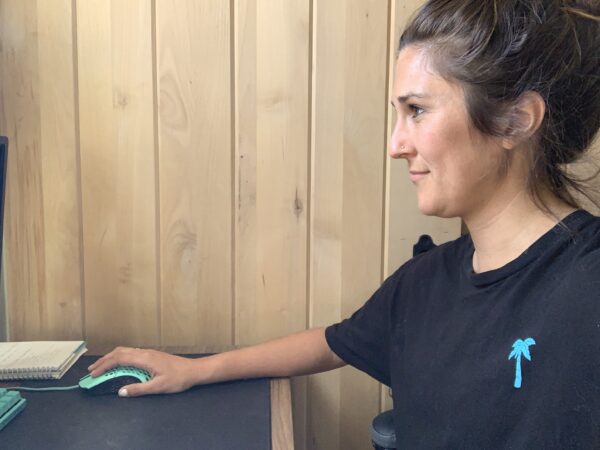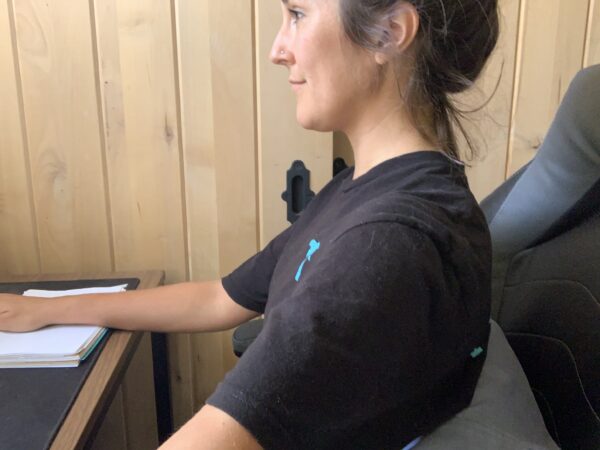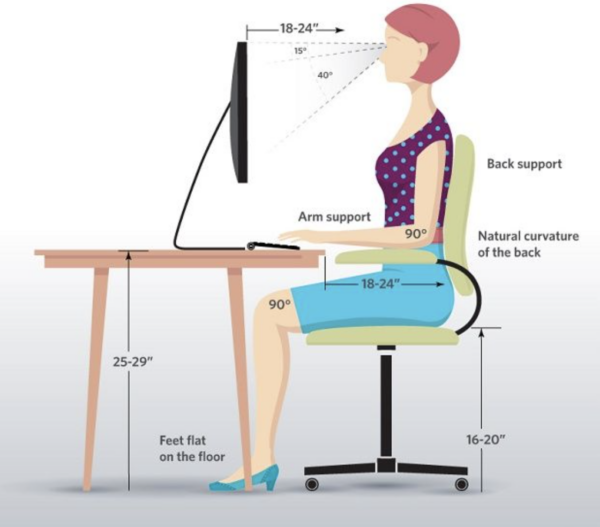Sitting for long periods of time is tough on the body… it can be a real pain in the neck (see what I did there?:). Sitting for an extended amount of time can put unnecessary pressure on the body. After 12 years working as a dental hygienist, and the last five years running my business, sitting for long periods is not new to me. In this article, I want to share some easy tricks on how to sit with good posture.
Is sitting for a long time a problem for your body? The short answer is yes. Here is an article with research sharing some of the harmful health effects that are attributed to sitting. To put it simply, our bodies were not designed to sit for extended periods of time. For this reason, there are a lot of issues that arise physically when we sit for longer periods of time. Plus, the problems that arise
I don’t know about you, but I have such good intentions for my posture when I first sit down to do work. The problem is that after a while, it becomes a lot more challenging to sustain that posture. That’s why I’m here today. I want to share some tips to improve posture when sitting at a desk. That way, you’ll be able to sustain better posture for long periods of time and reduce the rate of injury and pain.
I created another blog post with tips for having good posture when sitting right here for you. You may want to read that one first to build a foundation then come back to this post. Regardless, I hope this blog post helps you feel better when you’re sitting.
If you’re interested in different practices to help improve your posture by addressing mobility, strength and functional movement, you can check out my monthly yoga membership, Aligned Online. It’s unlike any other membership.
The adjustments I suggest below are pretty simple, and for some people, may even seem elementary. My invitation is to increase your awareness of your posture.. Ask yourself, “Am I really paying attention? Am I following these guidelines?” Check them out below and let me know what you think.
Adjustment #1: From Rounding to Shoulders & Neck Aligned for Good Posture


This one is much easier said than done. I don’t know how often I see people rounding their backs, hunching their shoulders and jutting their heads forward. This is one of the biggest issues I see amongst people who sit at a desk often.
Aside from esthetics, it isn’t good for the body to be out of alignment like this. Although it may not seem like a big deal to round the back and hunch the shoulders forward, it directly affects the head, jaw, neck, shoulders, upper back and the spine. I work with a lot of private clients who experienced jaw, neck and shoulder pain, and when we adjusted their alignment, the pain went away.
Tips: In order to sit up without the shoulders hunched, I highly recommend starting with your foundation–your feet and your hips. Make sure both feet are pressing into the ground evenly, and both hips are evenly on your chair. From there, lengthen your spine from hips to the top of your head. I like to imagine a string tied to the top of my head, lifting and lengthening me upwards.
With that, draw your chin *slightly* in towards the chest so your head is aligned over your spine and the back of your neck is long. Then draw your shoulders down away from your ears.
It’s important to note that in order to bring the shoulders back and align the head over your spine properly, you may need some stretching and/or strengthening practices. This is where yoga comes in. You can use therapeutic yoga to target these muscles to help improve mobility and stability so that holding proper posture is attainable.
For classes specific to posture, check out Aligned Online, my monthly membership program. There are tons of classes on there targeted to improve your posture and help you ditch pain for good.
Adjustment #2: From Elbow Out to In for Better Sitting Posture


Making sure your elbows aren’t splaying out to side is a big one. Most people who sit in general, never mind at a desk, tend to let their elbow drift out to the side. This brings the shoulder out of alignment, causing more strain on the shoulder joint and the neck. In addition, it makes it harder for your circulation to move fluidly throughout your neck, shoulder, arm and hands.
Whether you’re driving, sitting on the couch, or at your desk, see if you can bring your elbow closer towards the side of your body. This way, you can focus on aligning the shoulders and neck properly without added wear.
There are specific muscles that help to bring the shoulder back and down the back. When these muscles are active and functioning properly, it makes it challenging to let your elbow splay out. There are plenty of practices & trainings focused on helping you improve posture and alignment in this area on the Aligned membership website, so if you’re thinking, “I need this to learn this” or “I want better posture,” what are you waiting for? Better posture awaits you.
Adjustment #3: Align Your Hand and Wrist to Improve Posture

One thing most people don’t think about is how their hand and wrist are positioned. I see this most often when people use a mouse with their computer. If your wrist is at an angle, and your hand is elevated, or in flexion, when using a mouse, this could pose a problem.
Ideally, your don’t want your wrist in flexion for extended periods of time. Never mind is that not proper alignment, but it also cuts off the circulation to your hand and wrist. When you’re sitting for long periods of time, circulation to your hand and wrist is important. We don’t want tightness, overuse and inflammation all rolled into one.
To address this easily, you can buy a little pad that you’d place behind your mouse pad and under your wrist/forearm. This helps to bring your forearm, wrist and hand in on plane, allowing blood to move through with ease. This may also be addressed by adjusting the way you sit. For example, if your seat is too low, it will be hard to adjust this angle. Try out a couple of these options to see which one is most helpful for you.
Creating Better Habits for Better Posture
When it comes to improving your posture when sitting, it’s important to remember that it’s a marathon, not a sprint. What I mean by that is: it likely took you a long time to form the habits you have now. Don’t expect them to change over night. Focus on one or two things throughout the day until they become habitual for you. Curious to know more about habits? Check out this study on healthy habit formation.
They say it takes 90 days to create a habit that’s sustainable, so again, think about the long-term game, not just the short term wins.
I work with private clients a lot on ergonomics in the workplace. These three tips are almost always addressed with each of my clients throughout our work together. What is most notable to me, however, is the fact that we are ALL different. Because we have different bodies, we have different needs. Don’t hesitate to get individualized support if you think it may be valuable. If you’re interested in seeing if you’d be a fit working with my holistic approach to improving posture and ditching pain, reach out to me here.
These tools last a lifetime. Your health and your posture create a ripple affect for the rest of your life. When you feel good in your body, your feel good in your mind. And good health is invaluable.

Leave a Reply